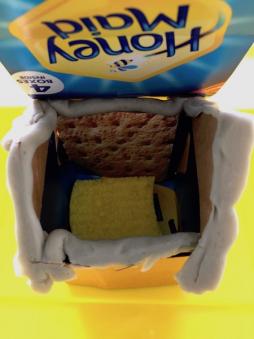ACTIVITY: Designs That Survive Storms
Students build a model home, and using information obtained in their experiment, explore the merit of their design and make an argument for how well their model would perform in a hurricane.
Students explore how hurricanes cause damage to houses and investigate the effect of design on the structural integrity of a house
Students model hurricanes to explore natural hazards.
| The activity below draws from the content in the page Designs Solutions for Hazards. |
Phenomenon:
Large storms bring destructive winds, rain, and storm surge.
Inquiry:
What materials or building designs help a house survive a storm? How can homes be built, or modified, to keep people dry and safe during strong storms?
Guiding Questions:
- How can we build our homes to withstand hurricanes?
- What elements are important to consider when preparing for natural hazards?
Activity:
Build a cardboard house and engineer storm-resistant features.
Watch:
A demonstration of this activity on a NOAA Live! Webinar (recorded Feb 3, 2021).
Materials:
- Student worksheet and teacher answer guide (attached below):
This teacher guide follows the procedure written here and in the student worksheet with additional instructions and guidelines. We highly recommend starting this activity by introducing the Phenomenon, Inquiry, and Guiding Questions from the top of this webpage.
Part A: Build a House:
- thin cardboard (cereal and cracker boxes work well, and using the part over the fold is fine)
- scissors
- pen or pencil
- cardboard house template or ruler
Part B: Testing Storm-Resistance
Storm-simulating materials:
- fan
- large tray
- water
- measuring cup
- water pouring device
- sponge (without scour pad; normal size cut in half works well)
- measuring cup or graduated cylinder (or other liquid measuring device)
House designing materials:
- attaching material (e.g., playdough, string, paper clips, glue, hot-glue, tape)
- waterproof material (e.g., plant leaves, foil, paint, waxed paper)
- lifting material (e.g., playdough, blocks, chopsticks, small rocks)
|
Teacher Recommendations:
|
Procedure:
Build Your House
- Build a simple house using only cardboard, scissors, a ruler, and the house template. (One house per group of 2-4 works well.)
Wind Simulations
- Test your cardboard house in high wind conditions (using a fan) (Video 1).
Video 1. Wind at speed 1 (lowest) tested on a house without modification. - Experiment with turning your house so that different sides face the fan (Video 2).
- Is there a difference? Describe.
Video 2. Wind speed 1 (lowest) tested on a house without modification facing an alternate direction.
- Is there a difference? Describe.
- Write down observations about what happens to your house.
- Think of modifications and write a hypothesis about how they will help your house survive in strong winds.
- Modify your house (Fig. 1).
Image caption
Fig. 1. Cardboard house made using the provided template and reinforced with playdough "tie-downs" for added strength and wind protection.
Image copyright and sourceImage courtesy of Kanesa Duncan Seraphin.
- Test your modified house against the high winds.
- Use the most destructive placement of your house (from step 2a).
- Use the same fan, and start at low speed.
- Increase the fan speed to test your design modification at higher wind speeds.
- Observe and describe what happens.
Video 3. Wind speed 4 (strongest) tested on a house (in same position as video 1) with a reinforced roof.
- Modify your house (Fig. 1).
Flood and Rain Simulations
-
Image caption
Fig. 2. 1/2 a dry household sponge placed in house to collect rain and flood water.
Image copyright and sourceImage courtesy of Karen Duncan.
Rain on your house!
- Place your house in a bucket or other water-catching device.
- Remove the roof and place a dry sponge inside (Fig 3). Replace the roof.
- Make it Rain! Use the measuring cup to slowly pour 2-3 cups of water over the house (Video 4). You may have to experiment with how much water to use, but the same amount should be used in each rain trial so that you can compare.
- What happens to the roof?
Video 4. Rain pouring down the roof of a model house without modification. - What happens to the bottom of the house?
Video 5. Effect of flood water on the model house. - Can you tell if more water is coming in through the roof or the bottom?Image caption
Fig. 3. Sponge water squeezed into graduated cylinder (about 30ml).
Image copyright and sourceImage courtesy of Karen Duncan.
- How could you test your hypothesis?
- Remove the sponge from the house and squeeze the water into the graduated cylinder (Fig 4). Measure the amount of water.
- What happens to the roof?
- Engineer modifications to make your house more water resistant. Remember that water can reach your house from above and below.
- Think of modifications and write a hypothesis about how they will help your house survive in strong rain and floods.
- Modify your house.
- Test your modified house again against rain and flooding. Observe what happens and then write a statement to claim how your engineering design:Image caption
Fig. 4. Student cardboard house retrofitted with plant leaves for water-resistance, and playdough stilts to withstand flooding.
Image copyright and sourceImage courtesy of Kanesa Duncan Seraphin.
- did (or did not) help the house stay dry in strong rain.
- did (or did not) help the house stay dry when the ground was flooded.
Activity Questions:
- Which material or design that worked best to protect your cardboard house against the followng. For each claim, provide evidence and write out your reasoning.
- Wind?
- Rain?
- Flooding?
- In this activity, the rain came straight down and the flood water was not moving. However, during a storm, water can move quickly with a lot of force. How do you think fast moving water would affect your house differently?
- During tsunamis, a lot of damage can be caused by large objects moving with rushing water. How can we help protect buildings from things like telephone poles and shipping containers washing around in the water?
- During hurricanes, many people cover their windows with hard material, like plywood. How does this help protect their home?
- Describe the area where you live and the types of threats to the home you live in.
- For example, do you live near the ocean, near a stream, or somewhere very windy or rainy?
- Did native people in your area engineer homes to survive severe storms? What do you think, and what is your evidence?
- What types of engineering modifications might help make the home you live in more storm-proof?













Traditional, living grass roof